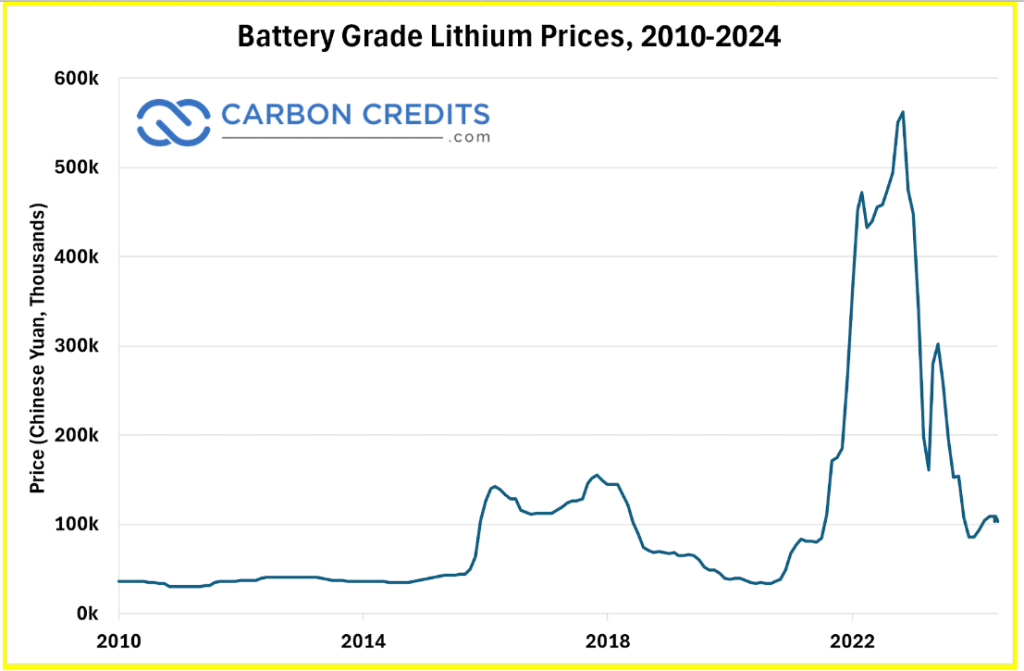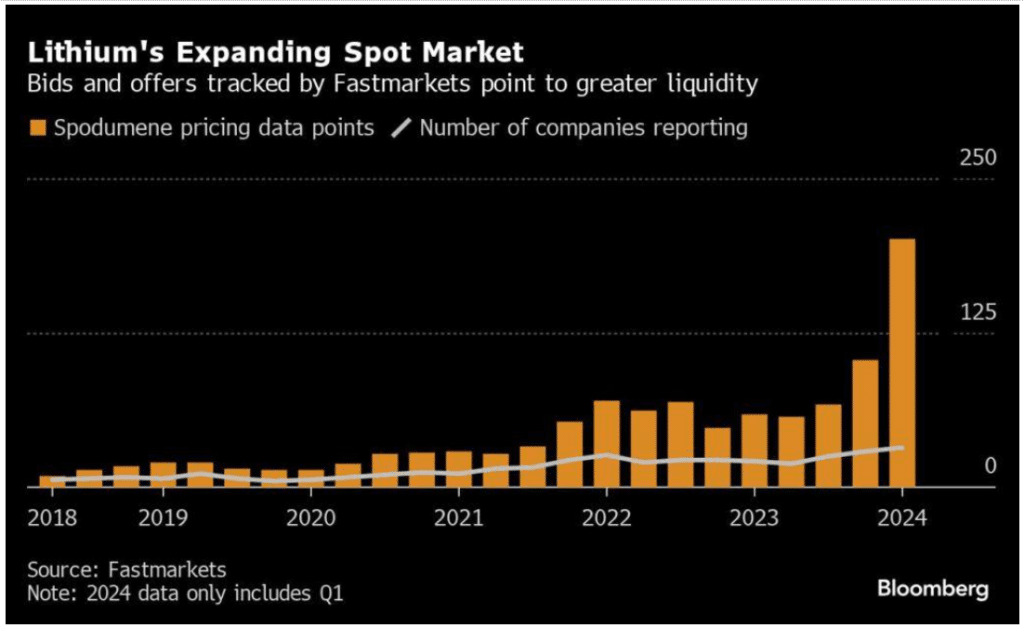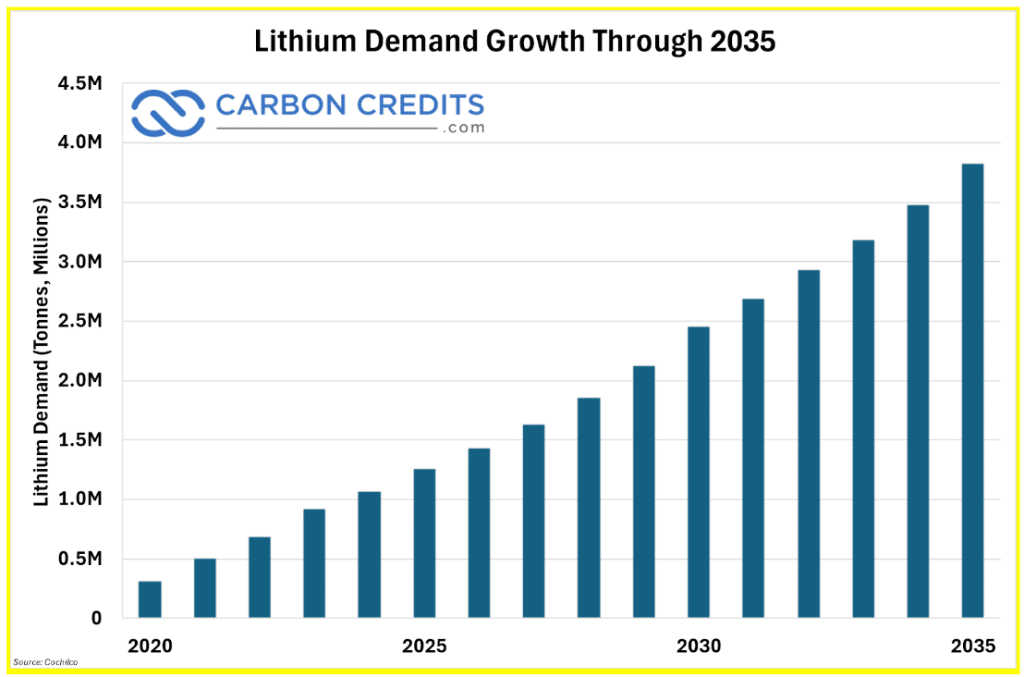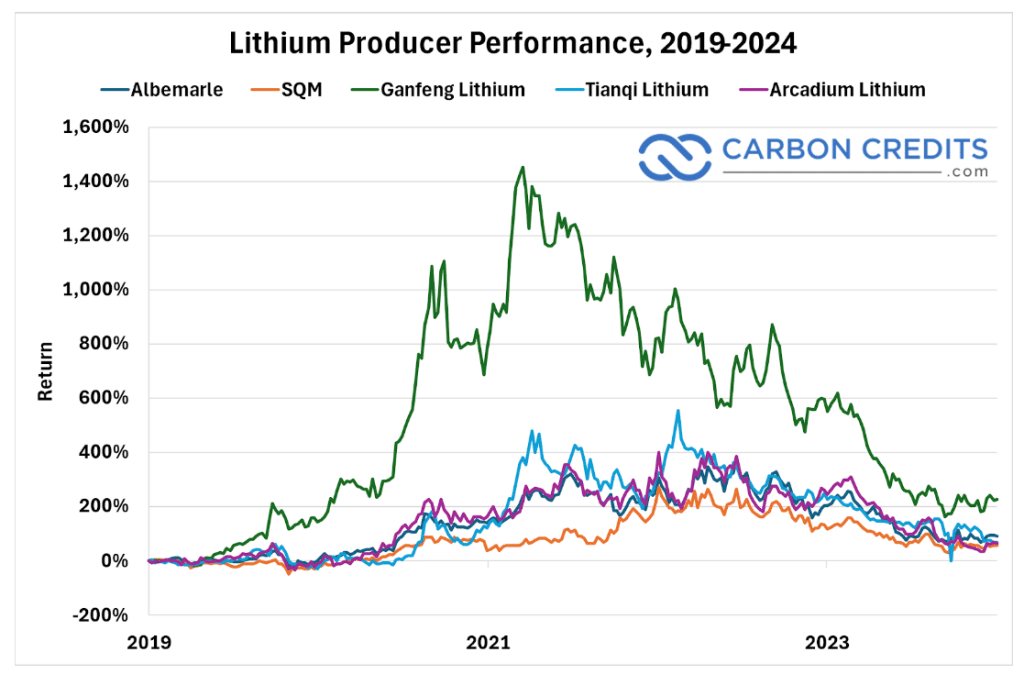Lithium, a critical element in modern technology, has become a focal point in discussions about renewable energy and electric vehicles (EVs) due to its importance in batteries. The fluctuating prices of lithium have significant implications for industries and economies worldwide. This article explores the dynamics of lithium pricing, offering insights into historical trends, current market conditions, future predictions, and the key factors that drive its valuation.
Background Information
Lithium is a soft, silvery-white metal belonging to the alkali metal group. It is highly reactive and flammable, making it essential in various industrial applications. Most notably, lithium-ion batteries power everything from smartphones to electric vehicles.
The demand for lithium has surged with the rise of renewable energy technologies and the global push towards reducing carbon emissions. Lithium’s unique properties make it irreplaceable in high-performance batteries, which are pivotal in energy storage solutions and portable electronics.
Lithium is also on several countries’ Critical Minerals lists, such as the U.S., Canada, and Australia.
Historical Lithium Price Trends
Lithium prices have seen dramatic changes over the past decade. From 2010 to 2015, prices remained relatively stable, with minor fluctuations due to steady demand and supply conditions. However, from 2015 onwards, prices began to soar, driven by the booming EV market and increased demand for renewable energy storage solutions.
By 2017, lithium prices had tripled compared to their 2015 levels. This spike was primarily due to the rapid expansion of China’s EV market and increased lithium mining and production investments.
The year 2018 saw prices peaking, but by 2019, an oversupply in the market led to a sharp decline. From 2019 to 2021, prices remained subdued, reflecting a period of market correction and stabilization.
In 2022, however, a record-breaking price rally occurred due to a large supply deficit. Lithium’s largely agreement-based supply model also contributed to this squeeze, sending lithium prices skyrocketing over 5x. This push would continue until midway through the year as China re-implemented full lockdowns nationwide due to rising COVID-19 case numbers, leading to a brief economic slowdown.
While the end of lockdowns coincided with another surge in demand, sending lithium prices to their all-time high of 575,000 CNY (USD 80,000) per tonne, this rally was short-lived. With inflation rates on the rise and EV supply finally overtaking demand, lithium prices plummeted back down in 2023 before stabilizing around the 100,000 CNY (USD 14,000) level, where it continues to trade today.


The past few years have been marked by significant market adjustments. Producers ramped up supply, anticipating continuous high demand, but the market did not grow as quickly as expected.
Consequently, this led to a surplus, driving prices down. Moreover, technological improvements in mining and processing lithium contributed to cost reductions, which also played a role in lowering market prices during this period.
Lithium Price Volatility
One of the main factors contributing to the volatility of lithium prices is that unlike other minerals like gold or copper, the lithium markets are still fairly young and hence the spot market is not very well established. With the recent explosive growth in lithium demand added on top of that, the result is a market sector that’s very much still going through growing pains.
Right now, instead of purchasing contracts for delivery on a spot market most lithium consumers choose to directly sign long-term offtake agreements with lithium miners, securing a guaranteed supply at a fixed price. The current state of the lithium markets has drawn parallels to the iron ore market prior to the 2010s, where pricing would follow an annual benchmark negotiated between miners and steelmakers each year.
In the early 2000s, explosive growth in iron ore demand from China was the catalyst that finally led to change in the iron ore markets. It would take a concerted effort from BHP and other top miners for the iron ore markets to shift towards the spot pricing model it follows today.
Something similar is happening in the lithium markets, with top producer Albemarle having begun holding auctions for its mined lithium since March 2024. These auctions allow buyers to secure pricing that’s more truly reflective of the present supply-demand dynamic, as opposed to being forced to lock in fixed long-term pricing to avoid not having enough supply.
 Albemarle plans on holding auctions every two weeks in order to provide more timely and consistent data on lithium pricing.
Albemarle plans on holding auctions every two weeks in order to provide more timely and consistent data on lithium pricing.
The lithium spot market has been seeing increasing activity as well, as shown in the chart above. In conclusion, while lithium prices will likely continue to be volatile for the foreseeable future, there are changes under way that will help stabilize the market as it matures and develops.


Current Market Analysis
As of 2024, lithium prices have stabilized from their major plunge of 2022-2023. The current price is attributed to several factors:
- Increased Demand: The global shift towards electrification and decarbonization has accelerated the demand for lithium-ion batteries. EVs, energy storage systems, and consumer electronics continue to drive this demand. The Paris Agreement and other international efforts to curb carbon emissions have further intensified the focus on lithium as a key resource for achieving climate goals.
- Supply Chain Dynamics: While demand is rising, supply chain disruptions have hindered the steady flow of lithium. These disruptions are caused by geopolitical tensions, logistical challenges, and regulatory hurdles in major lithium-producing countries. For instance, political instability in regions like South America, where a significant portion of lithium is mined, has led to production slowdowns and export restrictions. However, there is still a significant surplus of lithium supply to work through.
- Technological Advancements: Innovations in battery technology, such as solid-state batteries, promise higher efficiency and longer life cycles. These advancements have spurred further investment in lithium production, contributing to the current price dynamics. Additionally, advancements in extraction technologies, such as direct lithium extraction (DLE), are expected to enhance the efficiency and environmental sustainability of lithium production.
The increased focus on domestic production in countries like the United States and Australia is also reshaping the market landscape. Efforts to reduce dependence on imported lithium are driving investments in local mining projects, which, in turn, affect global supply and pricing dynamics.
Future Price Predictions
Looking ahead, the future of lithium prices is shaped by a combination of technological, economic, and geopolitical factors.

 Analysts predict that demand for lithium will continue to grow, driven by several key trends:
Analysts predict that demand for lithium will continue to grow, driven by several key trends:
- Expansion of the EV Market: With governments worldwide setting ambitious targets for EV adoption, the demand for lithium is expected to skyrocket. For instance, the European Union aims to phase out internal combustion engine vehicles by 2035, significantly boosting lithium demand. Major automakers are also announcing aggressive plans to electrify their fleets, further driving demand.
- Advancements in Energy Storage: Beyond EVs, the need for efficient energy storage solutions in renewable energy systems will drive lithium demand. Solar and wind energy projects increasingly rely on lithium-ion batteries for energy storage, ensuring a steady demand. The development of grid-scale storage solutions is particularly significant, as it addresses the intermittency issues associated with renewable energy sources.
- Sustainable Mining Practices: The push for sustainable and ethical mining practices may impact the supply side. While this could constrain supply in the short term, it is expected to ensure a stable and environmentally friendly lithium supply in the long run. Innovations in recycling technologies and the development of closed-loop systems are also expected to play a crucial role in meeting future demand sustainably.
Factors Affecting Lithium Prices
Several factors influence lithium prices, creating a complex and dynamic market landscape:
- Supply and Demand Dynamics: The fundamental economics of supply and demand play a crucial role. Any imbalance, such as oversupply or undersupply, directly affects prices. For example, the rapid development of new mining projects can lead to temporary oversupply, depressing prices until demand catches up.
- Geopolitical Factors: Lithium-rich countries, such as Australia, Chile, and Argentina, play a significant role in the global supply chain. Political stability and regulatory policies in these regions can impact lithium prices. Trade policies, tariffs, and international agreements also influence the global flow of lithium and its pricing.
- Technological Developments: Breakthroughs in battery technology can influence lithium demand. For example, the development of alternative battery chemistries could reduce reliance on lithium, affecting its price. Conversely, improvements in lithium extraction and processing technologies can increase supply efficiency and reduce production costs, impacting prices favorably.
- Environmental Regulations: Stricter environmental regulations on mining practices can limit supply and drive up prices. Conversely, advancements in sustainable mining techniques can stabilize prices. The growing emphasis on reducing the environmental footprint of lithium extraction is prompting the industry to adopt greener practices, which may initially increase costs but lead to long-term sustainability.
Key Players in the Lithium Market
The global lithium market is dominated by a few key players who control a significant share of the mined supply. Here are five of the top producers from 2023, who combined for roughly half of total global production:
- Albemarle Corporation: Currently the world’s largest lithium producer, Albemarle operates major lithium mining projects in Australia and the United States. The company has invested heavily in expanding its production capacity to meet rising demand.
- SQM (Sociedad Química y Minera de Chile): Based in Chile, SQM, the world’s second largest producer, is known for its extensive lithium brine operations in the Atacama Desert. The company has leveraged its strategic location and technological expertise to become a dominant player in the market.
- Ganfeng Lithium: A Chinese company, Ganfeng is a major player in the lithium market, with operations spanning from mining to battery production. The company’s vertically integrated business model allows it to control the entire supply chain, ensuring stable supply and competitive pricing.
- Tianqi Lithium: Another Chinese giant, Tianqi, has significant stakes in lithium mining operations globally, including the Greenbushes mine in Australia. The company’s strategic investments and partnerships have positioned it as a key supplier in the global market.
- Arcadium Lithium: A vertically integrated lithium company formed from a merger between American refiner Livent and Australian miner Allkem, Arcadium focuses on high-quality lithium compounds used in batteries and other applications. The company’s commitment to innovation and sustainability has made it a preferred supplier for many high-tech industries.


Challenges and Opportunities
The lithium market faces several challenges and opportunities that will shape its future:
Challenges:
- Environmental Impact: Lithium mining has significant environmental repercussions, including water usage and habitat destruction. Addressing these concerns is crucial for sustainable growth. The industry is under increasing scrutiny to minimize its environmental footprint and adopt greener practices. Expect to see a more pronounced price premium for “green” sustainable lithium once the market matures further.
- Market Volatility: Fluctuations in supply and demand combined with the infancy of the lithium markets can lead to volatile prices, making it challenging for investors and producers to plan long-term strategies. The cyclical nature of commodity markets adds to the unpredictability, requiring robust risk management practices.
- Technological Risks: Dependence on lithium-ion technology poses a risk if alternative battery technologies emerge, potentially reducing lithium demand. The rapid pace of technological innovation necessitates continuous adaptation and investment in research and development.
Opportunities:
- Technological Innovation: Advancements in mining and processing technologies can enhance efficiency and reduce environmental impact. Innovations such as direct lithium extraction (DLE) and improved recycling techniques are expected to revolutionize the industry.
- Strategic Investments: Investing in lithium recycling and alternative sources can diversify supply and stabilize the market. Developing secondary sources of lithium, such as extracting lithium from geothermal brines or recycling used batteries, offers promising avenues for ensuring supply security.
- Global Collaboration: International cooperation on sustainable mining practices and environmental regulations can ensure a stable and ethical lithium supply chain. Collaborative efforts among governments, industry players, and environmental organizations can drive the adoption of best practices and foster a resilient market.
Types of Lithium Companies: Technology, Exploration, Production, Extraction, Refining
The lithium industry comprises various types of companies, each playing a crucial role in the supply chain. These companies can be broadly categorized into technology, exploration, production, extraction, and refining. Understanding the distinct roles and contributions of each type is essential for grasping the complexity of the lithium market.
-
Technology Companies
Role and Contribution: Technology companies are pivotal in the development and advancement of lithium battery technologies. These firms focus on enhancing the performance, efficiency, and safety of lithium-ion batteries. Innovations by technology companies drive the demand for lithium by creating new applications and improving existing ones.
Examples:
- Tesla: Known for its electric vehicles (EVs), Tesla also invests heavily in battery technology through its Gigafactories, which produce lithium-ion batteries for both EVs and energy storage systems.
- Panasonic: Partnering with Tesla, Panasonic manufactures lithium-ion batteries, focusing on improving energy density and reducing costs.
Impact: Technology companies push the boundaries of battery capabilities, influencing the overall demand for high-quality lithium and driving advancements that make renewable energy solutions more viable and efficient.
-
Exploration Companies
Role and Contribution: Exploration companies are responsible for discovering new lithium deposits. These firms conduct geological surveys, drilling, and sampling to identify potential lithium reserves. Exploration is the first step in the lithium supply chain, determining future supply availability.
Examples:
- LiFT Power Corp: An exploration company focused on developing its lithium project in Northwest Territories, Canada, aiming to establish a domestic North American supply of lithium.
Impact: Successful exploration leads to the development of new lithium mines, increasing the global supply of lithium and potentially stabilizing prices. These companies are crucial for ensuring a steady pipeline of lithium resources to meet future demand.
-
Production Companies
Role and Contribution: Production companies are involved in the extraction of lithium from mines and brine sources. They manage the operations of lithium mines and are responsible for bringing raw lithium materials to the market.
Examples:
- Albemarle Corporation: The world’s largest lithium producer in 2023 with operations in Australia and the USA, Albemarle is a key supplier of lithium compounds to various industries.
- SQM (Sociedad Química y Minera de Chile): Operating extensive lithium brine extraction facilities in the Atacama Desert, SQM is a leading global producer of lithium.
Impact: Production companies are the backbone of the lithium supply chain, ensuring that sufficient quantities of lithium are available to meet industrial and consumer needs. Their production capacities and efficiencies directly influence lithium prices and availability.
-
Extraction Companies
Role and Contribution: Extraction companies specialize in the technologies and processes used to extract lithium from raw materials. These firms develop and implement methods for efficiently and sustainably extracting lithium from both hard rock (spodumene) and brine sources.
Examples:
- Standard Lithium: Known for its proprietary extraction technology that aims to streamline the lithium extraction process and increase efficiency.
Impact: Advancements in extraction technology by these companies can significantly lower production costs and environmental impact, making lithium more accessible and sustainable. Efficient extraction processes are essential for meeting growing demand while minimizing ecological footprints.
-
Refining Companies
Role and Contribution: Refining companies are responsible for processing raw lithium materials into high-purity lithium compounds that are suitable for use in batteries and other applications. These companies ensure that the lithium meets stringent quality standards required by technology and battery manufacturers.
Examples:
- Ganfeng Lithium: A vertically integrated company that not only mines lithium but also refines it into battery-grade compounds.
- Tianqi Lithium: Engages in refining lithium to produce battery-grade lithium hydroxide and carbonate, supplying major battery manufacturers.
Impact: Refining companies add value by transforming raw lithium into a usable form, ensuring a consistent supply of high-quality lithium to downstream industries. Their operations are critical for maintaining the supply chain’s integrity and meeting the specifications required for advanced lithium-ion batteries.
Conclusion
Lithium prices are influenced by a myriad of factors, from technological advancements and supply chain dynamics to geopolitical and environmental considerations. The future of lithium pricing looks promising, with growing demand driven by the global shift towards electrification and renewable energy.
However, addressing the challenges of sustainable production and market volatility will be crucial for long-term stability. As the world continues to embrace green technologies, lithium remains a critical component in the journey towards a sustainable future.
References and Further Reading
- Lithium Market Overview and Trends. (2023). International Energy Agency. https://www.iea.org/reports/critical-minerals-market-review-2023/key-market-trends#abstract.
- The Future of Lithium: Supply, Demand, and Prices. (2023). BloombergNEF (https://about.bnef.com/blog/the-future-of-lithium-supply-demand-and-pr)
- SEO Powered Content & PR Distribution. Get Amplified Today.
- PlatoData.Network Vertical Generative Ai. Empower Yourself. Access Here.
- PlatoAiStream. Web3 Intelligence. Knowledge Amplified. Access Here.
- PlatoESG. Carbon, CleanTech, Energy, Environment, Solar, Waste Management. Access Here.
- PlatoHealth. Biotech and Clinical Trials Intelligence. Access Here.
- Source: https://carboncredits.com/understanding-lithium-prices-past-present-and-future/



